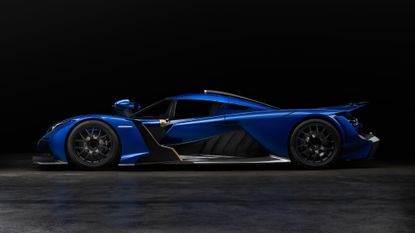Praga Bohema supercar’s Czech racing heritage shines through
The Bohema, from Czech manufacturer Praga, is a petrol-powered two-seater with competition in its genes and outrageousness in every curve
- (opens in new tab)
- (opens in new tab)
- (opens in new tab)
- Sign up to our newsletter Newsletter

Car brands never actually die; they just linger in obscure ownership for decades until the time is deemed right for resurrection. Such is the case with Praga, a Czech company that can trace its origins back to the days of heavy industry in the late 19th century. As the new century dawned, it joined the crowded ranks of early automobile manufacturers.

Praga was fit enough to survive, eventually becoming a big name in Czech transportation, building lorries, motorbikes, and even race cars. In the Communist era, Praga was handed the task of building the country’s trucks, while others (notably Skoda) got the contract for building passenger cars. It wasn’t until the Communist party was ousted in 1989 that Praga became a private company once more.

Since then, Praga has been active in the fringes of motorsports, building motocross bikes and racing trucks for endurance racing, as well as opening an aviation division. It has also been involved in creating specialist racing cars such as the Praga R4S and R1.

Praga Bohema: at once avian and alien
Nevertheless, not a lot of people outside the industry know the Praga name, which is why this new ‘road legal track-focused’ hypercar, the Bohema, comes as such a surprise. The company plans to build an edition of 89 units of the two-seater, which has been tested by F1 and IndyCar driver Romain Grosjean.

The Bohema hits all sorts of high-value metrics, as befits a machine pitched at the wealthiest track-day enthusiasts. The list price is around £1.1m, the engine is a tried and tested 6-cylinder unit developed from the Nissan GT-R, said to develop 700hp, and the top speed is around 300 km/h. There’s no shortage of visual drama either, with curved and crimped bodywork (developed in-house) that somehow looks both avian and alien at the same time.

The company has parlayed its racing knowledge into saving weight, with a dry target of 982kg, thanks to chassis, bodywork and components made from carbon fibre, magnesium alloys and titanium. A wrapround canopy-style windscreen offers a straight-ahead view akin to that of a racing driver, with pronounced aero ducts behind the front wheels.
At the rear, storage is built into the rear wheel arches, including space for the all-important crash helmet, and the doors swing up and out in time-honoured supercar fashion, giving access to one of the extreme, race-style recumbent driving positions we’ve ever seen.

Praga hopes to build around 20 cars each year, giving new owners a hands-on track handover so they can learn how to get the most out of their car. Whether anyone will actually fulfil the Praga dream of driving calmly to a track to put down a few furious laps before heading home is hardly the point; this kind of machine exists as a statement of intent and potential.

Praga Cars, PragaGlobal.com (opens in new tab)
Jonathan Bell has written for Wallpaper* magazine since 1999, covering everything from architecture and transport design to books, tech and graphic design. He is now the magazine’s Transport and Technology Editor. Jonathan has written and edited 15 books, including Concept Car Design, 21st Century House, and The New Modern House. He is also the host of Wallpaper’s first podcast.
-
 Watch Ryuichi Sakamoto's mesmerising musical experience at the Brooklyn Museum
Watch Ryuichi Sakamoto's mesmerising musical experience at the Brooklyn MuseumAn iconic composer who traverses popular and high culture, Ryuichi Sakamoto pushes music into new frontiers, most recently in ‘Seeing Sound, Hearing Krug’, a new composition that pairs sound, flavour, light and texture
By David Graver • Published
-
 Last chance to see: ‘Strange Clay’ at The Hayward Gallery, London
Last chance to see: ‘Strange Clay’ at The Hayward Gallery, LondonAt London’s Hayward Gallery, group show ‘Strange Clay: Ceramics in Contemporary Art’ sees ceramic artists explore the physical, psychological, political and power of their medium
By Emily Steer • Published
-
 Aehra is Italy’s first all-electric luxury car brand. We preview its forthcoming SUV
Aehra is Italy’s first all-electric luxury car brand. We preview its forthcoming SUVAehra’s proposed electric SUV is brimming with cutting-edge technology. The Italian company hopes to shake up the high-end EV market in 2025
By Jonathan Bell • Published


